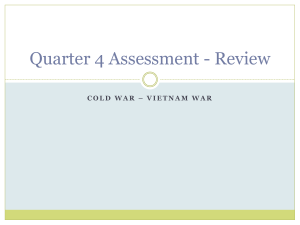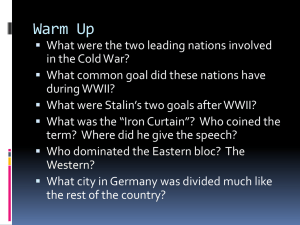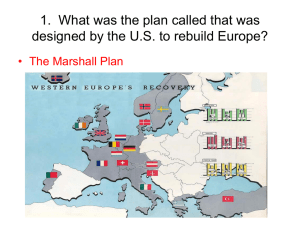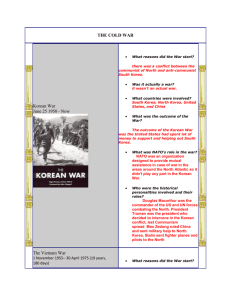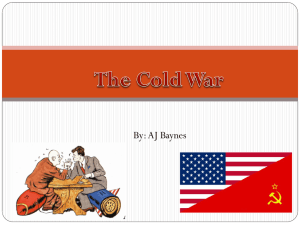Cold War: Key Events, Ideologies & Conflicts Presentation
advertisement
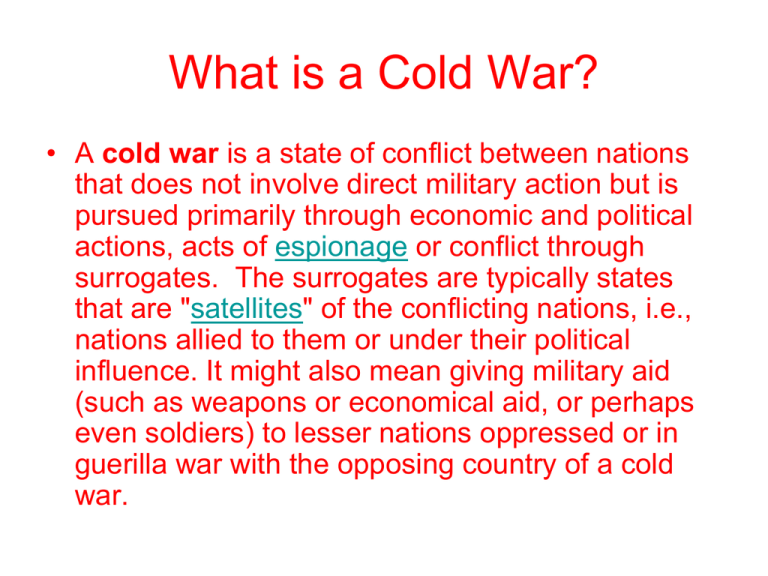
What is a Cold War? • A cold war is a state of conflict between nations that does not involve direct military action but is pursued primarily through economic and political actions, acts of espionage or conflict through surrogates. The surrogates are typically states that are "satellites" of the conflicting nations, i.e., nations allied to them or under their political influence. It might also mean giving military aid (such as weapons or economical aid, or perhaps even soldiers) to lesser nations oppressed or in guerilla war with the opposing country of a cold war. The Cold War • U.S. and Soviet Union had diff. goals and ideologies (ways of thinking about things), this causes a Cold War • U.S. is Democratic and Capitalist. • Soviet Union was a Dictatorship and Communist. Democracy vs. Dictatorship • Democracy - A form of government in which power is held by people under a free electoral system. • Dictatorship - A government controlled by one person or a small group of people. Capitalism vs. Communism • Capitalism – Economic system based on private ownership of the means of production and distribution, and characterized by profit, a free market, and open competition. • Communism – Economic idea that the community as a whole should own all property and run all business and industry East and West Germany • Germany was divided into 4 sectors, and 2 countries. • Soviet Union controlled East Germany • The U.S, France, and Great Britain controlled West Germany. Sectors of Berlin Berlin Airlift The Berlin Airlift June 27, 1948 to May 12, 1949 • The Soviets made no determined effort to disrupt the airlift. There are 2 likely reasons for this. – 1st - The Soviets saw no need to interfere with the airlift at first, because they believed it would fail. – 2nd - Disruption ran serious risks of triggering a war. Atomic Bomb Threat August 1949 • Soviets exploded their own atomic bomb • Truman developed even more powerful nuclear weapons for national defense • Hiroshima – At 0816 hours, in an instant, 66,000 people were killed and 69,000 injured by a 10-kiloton atomic explosion. • Nagasaki – In a split second, Nagasaki's population dropped from 422,000 to 383,000. Over 25,000 people were injured. • The Soviets were dominating Eastern Europe with communism, and the U.S. wanted to stop them. U.S. adopts 2 policies: • 1st - Containment(1947) – stop the spread of communism, or contain it. – 2nd - Truman Doctrine(1947) – U.S. would give money to countries to help them fight communism Alliances • North Atlantic Treaty Organization (NATO) – Military alliance with U.S. and 11 other countries to help defend each other in case of attack. • Warsaw Pact – Alliance between the Soviet Union and Eastern European nations (Stalin controlled) Communism on the Home Front • Red Scare – Americans were fearful of Communists living in U.S. • McCarthy’s Campaign – Senator Joseph McCarthy blamed the spread of communism on the presence of traitors within the U.S. government – McCarthy made serious accusations without proof and destroyed many lives. – In 1953 he declared that there were communists in the military and he was removed Korean War • The U.S. gains possession of Korea after WWII from Japan. • The U.S. and Russia partition Korea (38th parallel) like they did with Germany and Berlin – Russia controls North Korea – The U.S. controls South Korea Cold War Becomes Hot • War in Korea – North Korea invades South Korea – The U.S. did not want another country to be communist. – June 27, 1950 – U.N. members met to support South Korea – General Douglas MacArthur led U.N. forces into South Korea • North Koreans driven out of South Korea at one point, and North Korean Capitol captured • Chinese came in from the North and drove the U.N. forces out. • July 27, 1953, 2 sides signed cease fire agreement, war ended in stalemate • MacArthur wanted ground and air attacks on China, Truman refused, MacArthur lost his position after speaking out against Truman End of Korean War • After three years of fighting 2 countries remained divided by 38th parallel • Today – North Korea is a Communist Dictatorship – South Korea is a Capitalist Democracy Americans Fearful • U.S. was afraid the Soviet Union might use Cuba as a base to attack the U.S. and spread Communism into Latin America. (U.S. policy of containment) Conflict With Cuba • January 20, 1961 – John F. Kennedy became president • He wanted to help Latin America become Democratic, especially Cuba. • Cuba is 90 miles from Florida Bay of Pigs Invasion • April 1961 – Kennedy sent some 1500 Cuban exiles into the Bay of Pigs (Southwest coast of Cuba) • Castro’s forces attacked them = disaster • 1200 invading exiles captured, the rest killed Fidel Castro Berlin Wall Erected • August 13, 1961 – East German workers started building Berlin Wall – 27 miles dividing East and West Berlin – Kennedy sent 1500 troops to West Berlin to protest – Berlin Wall remained standing, the U.S. did not want war. Cuban Missile Crisis • 1961 – Soviet Union sending increased numbers of military personnel to Cuba • Summer 1962 – Soviets started arming Cuba with missiles , Soviets said missiles were to protect country from future invasions • September 1962 – Kennedy warned Soviet Leader Khrushchev not to place missiles in Cuba that could attack U.S. targets – Khrushchev denied anything being there – U.S. spy planes took photos proving otherwise • Pictures showed installation of nuclear missile launching pads with enough range to hit major Southeastern cities. • October 22, 1962 • Kennedy demanded Khrushchev remove missiles. – U.S. would attack the Soviet Union if they fired missiles anywhere in Western Hemisphere – Kennedy ordered the U.S. navy to surround Cuba and stop Soviet ships. (U.S. Blockade) • The Soviets removed missiles, and the U.S. promised not to invade the island. • November 22, 1963 – Kennedy assassinated by Lee Harvey Oswald – Lyndon Johnson takes office. • Soviets and Cubans worried they’re suspects. Vietnam War • The U.S. intervened to stop the spread of communism into South Vietnam (Domino Theory) U.S. Position • President Eisenhower developed the “Domino Theory” – if Vietnam fell to Communism, the U.S. believed all of Southeast Asia would fall like dominoes (China and North Korea already did) U.S. Involvement in Vietnam • Communists within South Vietnam – Vietcong – tried to take over the country with help from the North Vietnamese – North and South Vietnam divided by ideologies • South Vietnam was a Democracy led by Ngo Dinh Diem, who ended up being killed and South Vietnamese government officials took over • U.S. had been sending supplies to South Vietnamese • August 2, 1964 – U.S. destroyer attacked in Gulf of Tonkin (off Vietnamese coast) • August 7, 1964 – U.S. government passed Tonkin Gulf Resolution – President Johnson given power to take action • March 1965 – 1st U.S. combat troops arrived in South Vietnam (Operation Rolling Thunder – series of air attacks meant to destroy war industries in North Vietnam – it didn’t work) Home Front • Americans were divided over whether the U.S. should be involved militarily in Vietnam. End of the Vietnam War • 1973 – the U.S. pulled out of Vietnam • Vietnamization – U.S. trained South Vietnamese to carry on fight without them • 1975 – City of Saigon fell to North Vietnam • South Vietnam surrendered • Vietnam became a unified COMMUNIST COUNTRY End of the Vietnam War • The conflict ended in a ceasefire agreement… Costs of the War • Over 58,000 Americans died • 303,000 wounded • Veterans who came home were spit upon and called baby killers • Veterans suffered post-traumatic stress syndrome, they saw things in war that emotionally damaged them End of the Cold War • 1985 Mikhail Gorbachev came to power in the Soviet Union and pushed for reforms to move them closer to democracy. • One by one Soviet Republics declared independence • East Germans were able to leave their country • November 1989 – large group of prodemocratic activists began tearing down the Berlin Wall • October 1990 – West and East Germany were reunited • 1991 – Breakup of the Soviet Union into independent countries
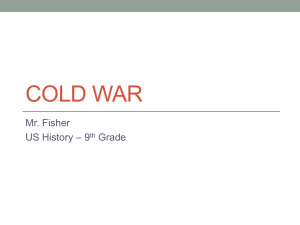

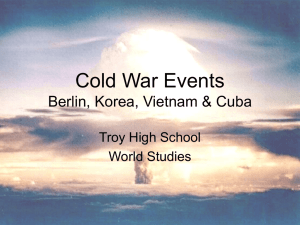
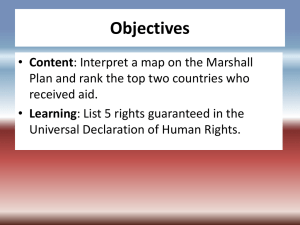
![vietnam[1].](http://s2.studylib.net/store/data/005329784_1-42b2e9fc4f7c73463c31fd4de82c4fa3-300x300.png)

